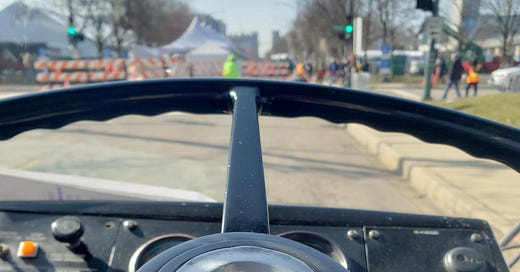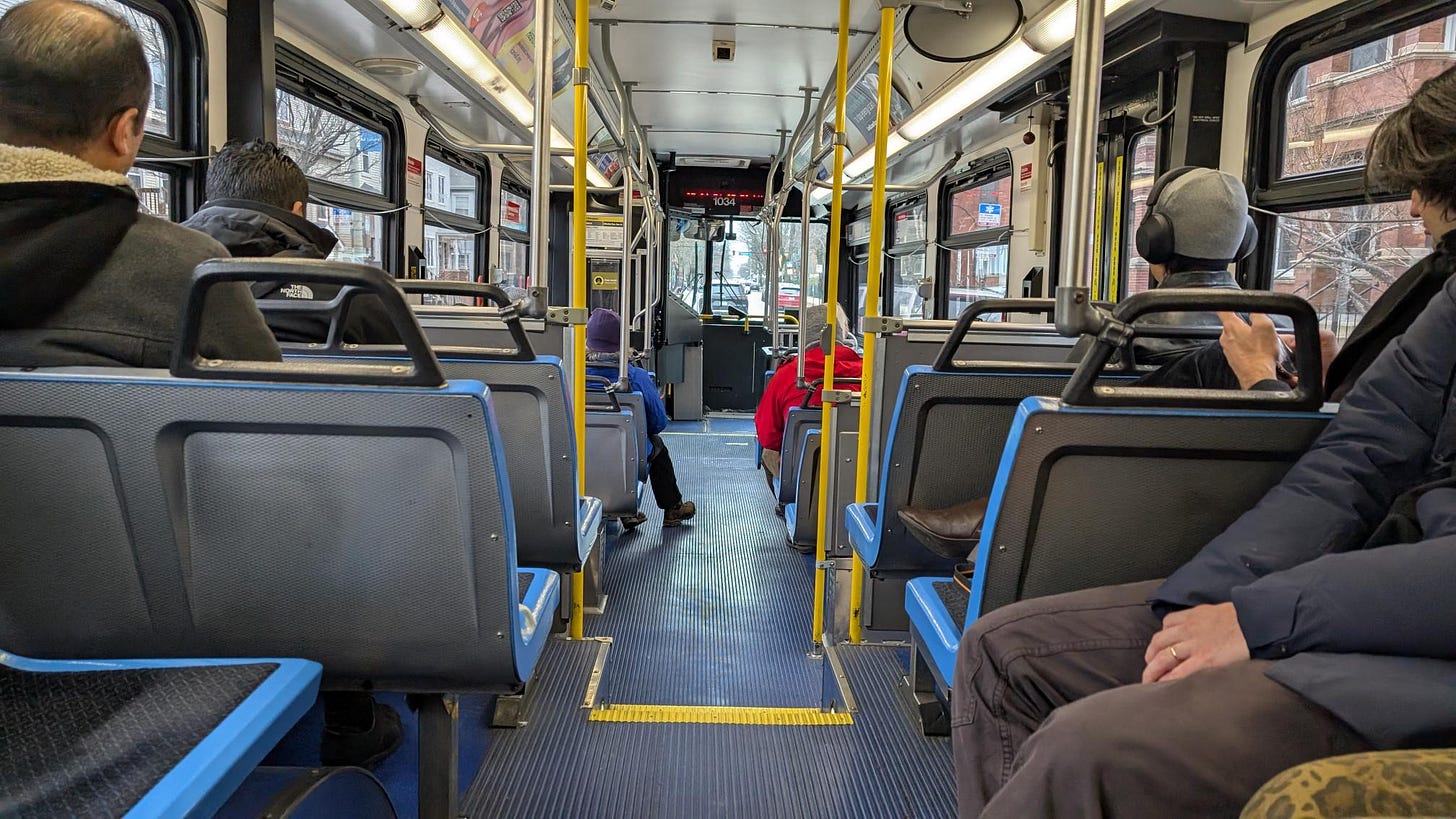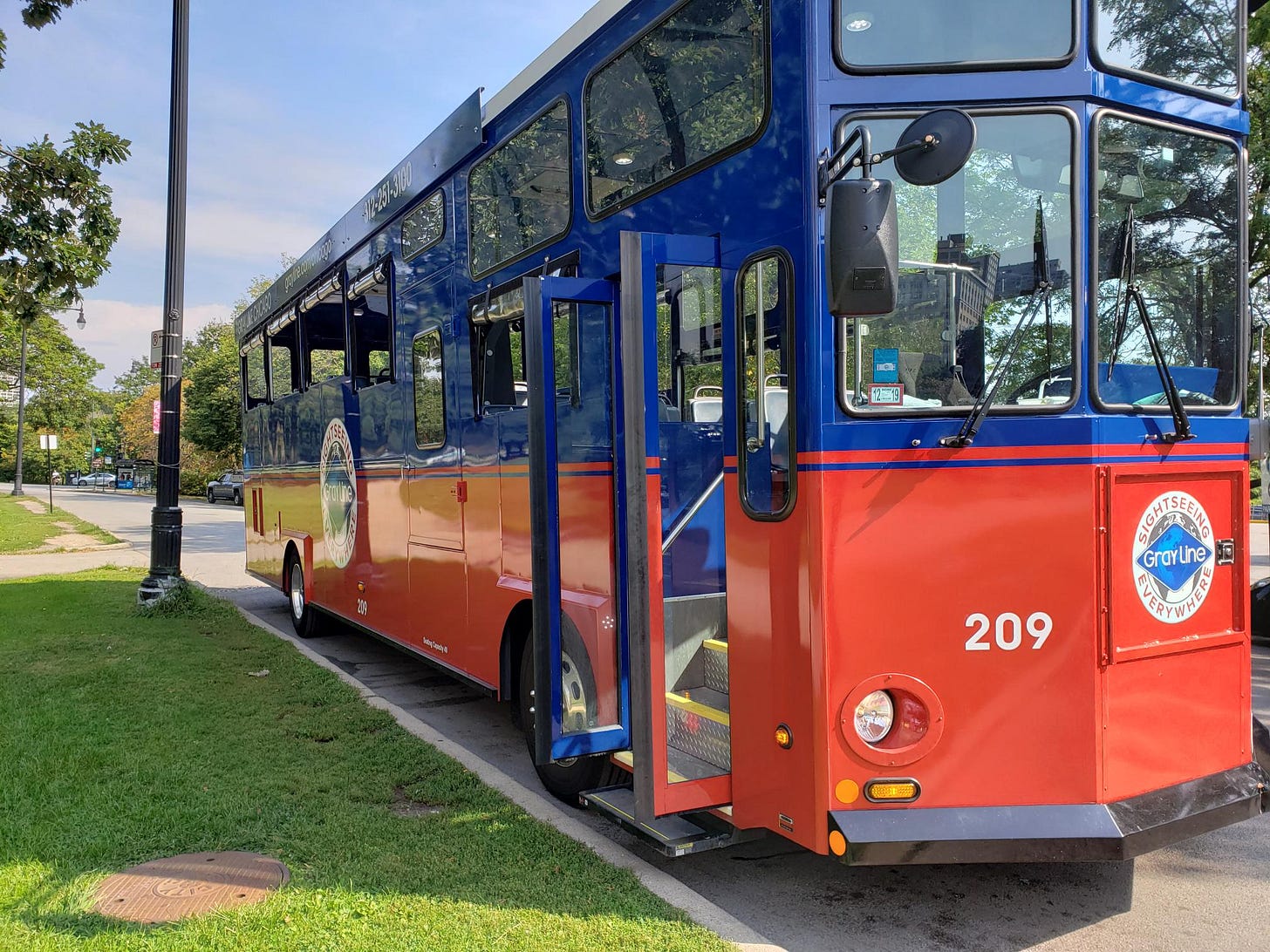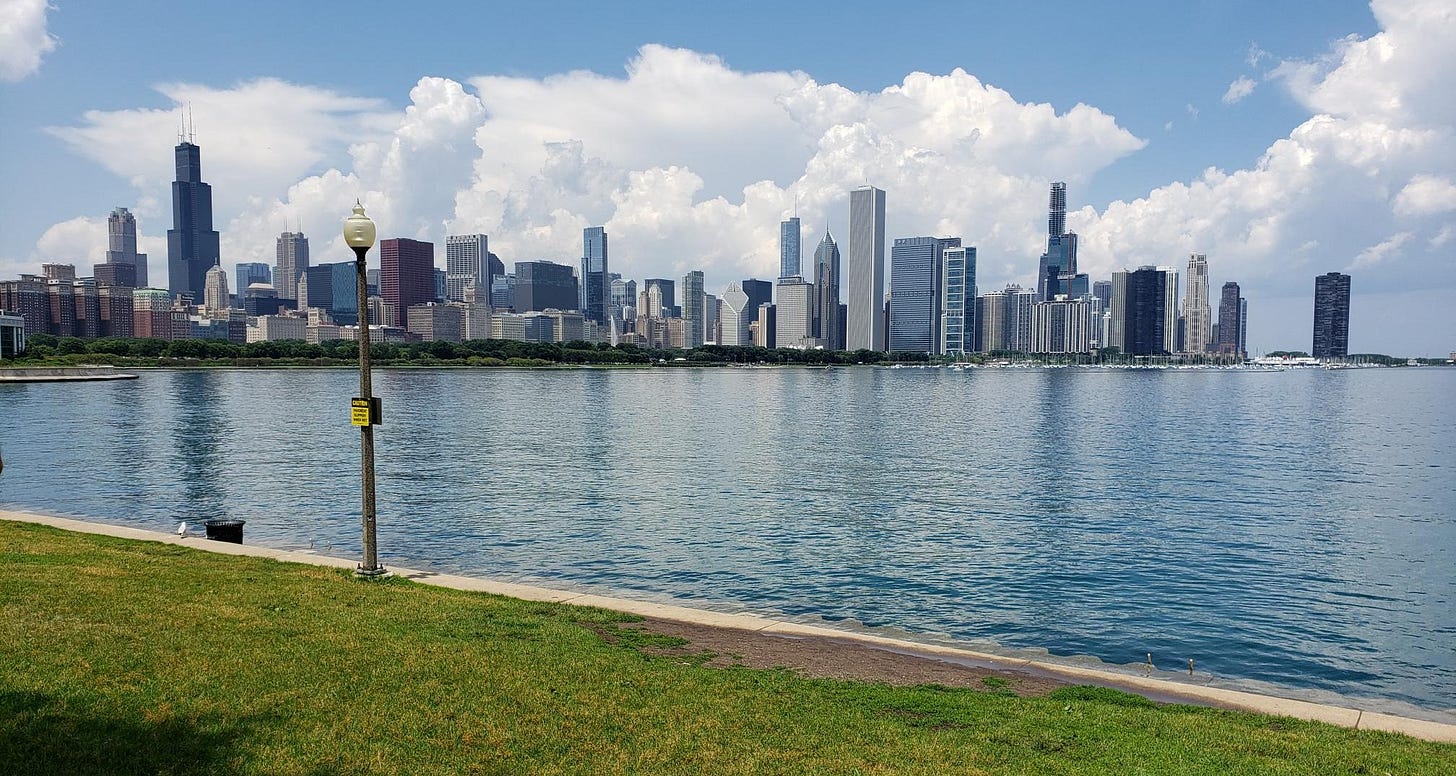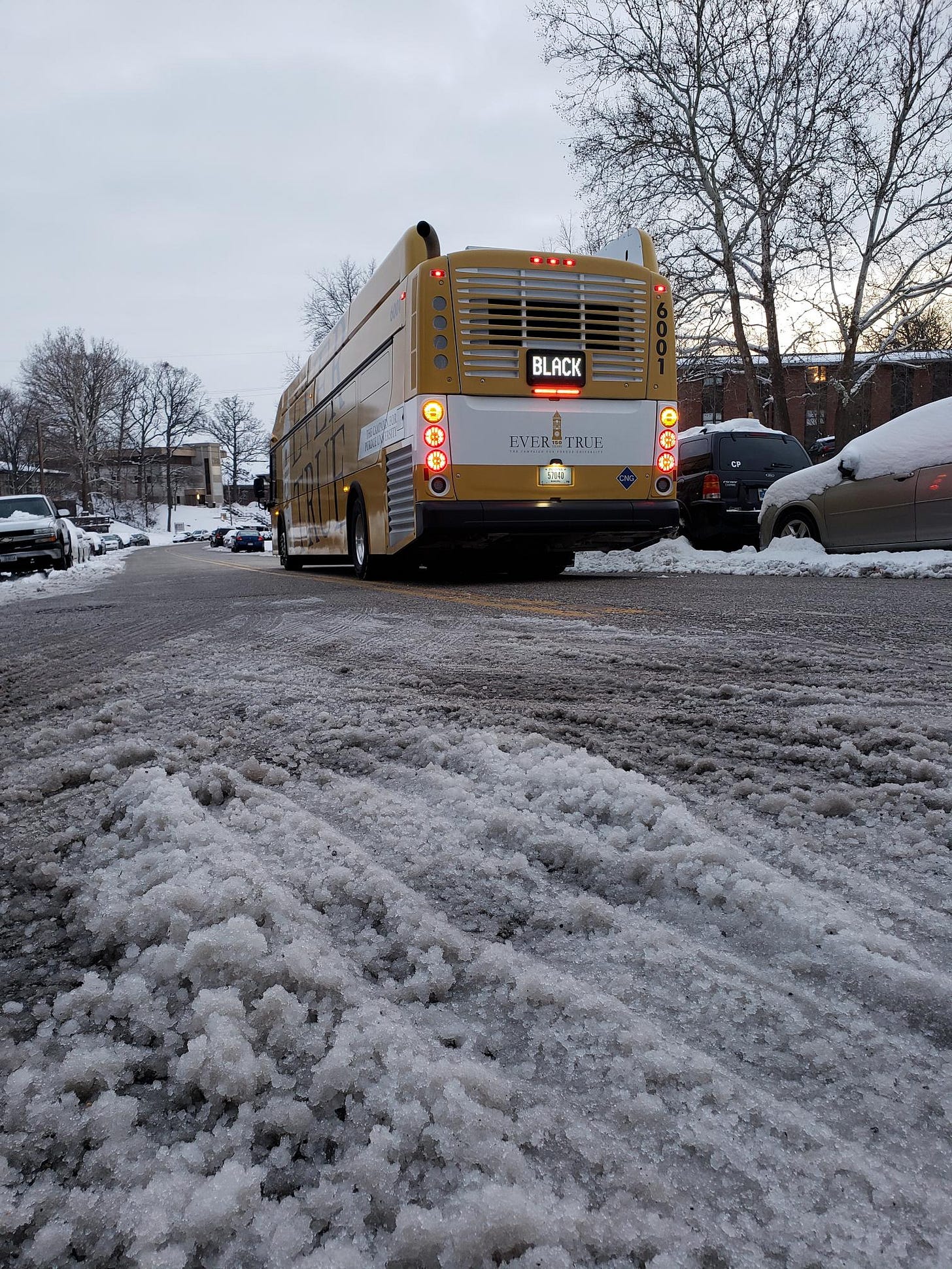Tales from the Driver's Seat
Driving a bus has taught me so much about life. Here are some of my favorite stories from behind the wheel! 🚌
Over the past decade, I've worn a lot of hats in the transit space. I’ve been a dispatcher, a scheduler, a de facto sign foreman, and most ambiguously, “the intern1”. Currently, I work as a transit planning consultant going from agency to agency hearing their challenges and offering my guidance for how to resolve them based on industry best practice and what I’ve learned from other agencies. However, of the roles I’ve held, by far the most formative has been “bus driver”.
Beyond the hard skills required to operate a 36,000 lb tube on wheels though city streets safely, this role has taught me patience, empathy, grace and imparted an understanding of the human condition in a way no other experience has come close. The bus is a quintessentially liminal space. Day in and day out, people of all ages, races, religions, incomes and occupations step through those doors, pay their fare, and coexist (mostly) uneventfully for the next 20 minutes.
Every few minutes, someone pulls the cord, a handful of people hop off the bus, a handful of people replace them, and the day continues. The cohort is never static, constantly refreshing as lives intersect and diverge over the course of several miles. Maybe you’ll see that person again tomorrow. Maybe you’ll never see that person again in your life.
For me, sitting in the driver’s seat observing this cadence of life is a humbling reminder that we’re all just sharing time, space and doing the best we can. Maybe I’m being melodramatic, but I think that’s really cool to see in real time.
After all that existential talk about bus driving and life, here are some of my favorite stories from my time behind the wheel.
That Empty Fifth
Anybody that has ridden the bus for some time will agree that bus routes have distinct personalities. The low frequency route running through mostly single-family residential neighborhoods has a distinctly different vibe than the high frequency route that passes through campus and downtown. Bus drivers understand this and use this to inform the routes they drive, governed by seniority.
Seniority (n) - A privileged position earned by reason of longer tenure at the transit authority. The driver that has been at the authority longest has the highest seniority. The most recently hired driver has the lowest seniority. Seniority rules are typically explicitly detailed in the collective bargaining agreement (CBO).
Collective Bargaining Agreement (n) - The union contract that results from collective bargaining. Collective bargaining is the process in which working people, through their unions, negotiate contracts with their employers to determine their terms of employment, including pay, benefits, hours, leave, job health and safety policies.
A driver looking for a chill run might gravitate to the low frequency, lower ridership route with long layovers, whereas a driver that feels like the day goes quicker if they keep moving might like the busy, high frequency line. Often, seniority means that the least desired routes go to the newest drivers2. While I have some preferences, I call myself a “trash man.” I do it for the people-watching and the love of the game, so I’m (mostly3) happy to take what everybody else avoids.
At one of my driving jobs, there was a route that was generally avoided because of the clientele. The people weren’t bad, but the route mostly served a lower income area of town, and the weight of life could ride a bit heavy on some of the passengers (it also tended to get a little rank in the summer4). I loved the route. It had some fun turns, operated 35’ buses instead of 40’ buses5, and I enjoyed the people. When you have less, you learn to appreciate the small things, and this imparts a perspective that I appreciate. In my experience, the riders were generally decent people doing their best with the cards life dealt them.
On the final stretch into the downtown transfer center, the route traversed a series of stop signs. At the first stop sign, somebody dropped an empty fifth and the glass bottle came clinking down the aisle. I took off and the bottle went clinking back down the aisle. I braked and here it comes. I accelerated and there it goes. This repeated itself until we reached the stop light at the end of the road.
Once we (and the bottle) stopped, a dude from the back of the bus shouts "wasn't mine!"
Better on the bus than behind the wheel. I threw the bottle away at my next layover.
The Shirtless South African Man
When I first moved to Chicago, I got a job at a charter bus company doing sightseeing tours in a 13’ tall, open-air (remember this detail) trolley6.
The tours consisted of 2, two-hour routes, complete with narration by yours truly. Passengers could mix and match or do all four hours in one fell swoop. I prided myself on giving a fun and engaging tour, but four hours can make for a long day, especially for kids not particularly interested in hearing about the 1893 World’s Fair or the Great Migration that defined Chicago’s Bronzeville neighborhood.
It was a balmy summer day when, amongst other passengers, a family with two kids (tweens) and a larger South African man7 joined for the full, four-hour tour. From the outset, the kids were clearly not here for it. They talked loudly for the first two hours. I gave the obligatory “please keep conversation to a reasonable volume” spiel a few times, but without parental support, there’s not much I can do8. Fortunately, the first half of the tour was pretty attraction heavy (the Bean, Wrigley Field, the Gold Coast), so the narration was second to the sightseeing. It also included a 30-minute stop at the Lincoln Park Zoo, which naturally diffused any interpersonal tension that might have built on the trolley. The first two hours were relatively uneventful, if not a little annoying.
The second two hours were more history heavy, and only featured a couple of quick photo stops.
Also, for whatever reason, it always seemed to get the hottest on this portion of the tour. Despite all this, I found this half of the tour more interesting. The history and attractions told less mainstream Chicago history. The kids did not share my enthusiasm. In fact, their disinterest was palpable. Their conversations were properly raucous.
At a local crescendo in their conversation, the South African man, clearly fuming in more ways than one (he had unbuttoned his shirt to cool off) reached his breaking point. He stood up, turned to to the family (parents and kids), and in a deep accent, shouted “will you guys please shut the f*** up.” For the first time in 3.5 hours, silence filled the trolley. The family was visibly shocked.
Content with the newfound silence, the man turned back around, took his seat and called out “Sorry about that Mr. bus driver.” “Not a problem!”, I replied, likely too quickly9. The kids, still stunned, didn’t say a word for the remainder of the tour. I gave the rest of my tour without incident. It’s so interesting how many conflicts on the bus reach a fever pitch before naturally resolving themselves. At the end of the tour, the South African man tipped me handsomely. The family did not. To this day, I still wonder how than man is doing.
Bonus Picture
I took this picture on my layover on a snowy day!
Fun Fact: This route involved a three point turn at the top of a hill. The routes primary purpose was to bring students involved in Greek life from their frat houses to campus. The houses were at the end of a cul-de-sac, so that’s where the bus went.
Because of the three point turn, this route required buses with back up cameras. However, older drivers once told me that before back up cameras were common, there was a rock in the grass, and you just backed up until you tapped the rock (this was when buses has big metal bumpers). Apparently, every now and again somebody had to come along and push the rock back to its starting position (kind of like a typewriter).
Thanks for reading! This is a new kind of content for me—something a little different from what I usually share. I'm experimenting and would really value your input. Let me know what you think in the comments!
This has included assisting in the training of bus drivers, writing federal grant applications, doing paper ride checks, tabling at public events, planning routes, pulling weeds and whatever else I could get roped into.
Yes, this creates retention issues
I draw the line at a bad schedule. If every bus driver runs late on a route, it’s probably a bad schedule. Bad schedules kill morale. Once a bus driver catches on that this route will always be late, it kills any motivation to try to keep it on time. The ones that do try will burn likely burn out. In addition to bus driver, scheduler is also a hat I’ve worn. To my fellow schedulers out there, stop making bad schedules (I’ll cover this in a future article)
Nothing some scented chapstick under the nose, or a drop of essential oils in a mask cant overcome
It’s wild how much that difference impacts maneuverability
I just celebrated my six-year work anniversary with this company. While the sightseeing tours did not weather the pandemic, I’m eternally grateful that the company did and continues to afford me flexibility to maintain my day job and moonlight as a bus driver.
He told me he was from South Africa.
I’ve never driven a school bus and never will
In my defense, I was shocked too. I agreed…but I was still shocked.

